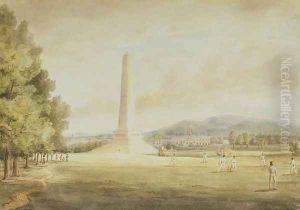John Hardman Powell Paintings
John Hardman Powell was a notable English architect and designer, most recognized for his contributions to the Gothic Revival style in the 19th century. He was born on July 25, 1827, in London, England. His career was significantly influenced by his association with the renowned architect Augustus Welby Northmore Pugin, who is often regarded as a pioneer of the Gothic Revival movement. Powell married Pugin's daughter, Anne, which further consolidated his connection to the Pugin family and their architectural legacy.
Powell's professional life was deeply intertwined with the Pugin family's firm, for which he started working in 1844. After Pugin's death in 1852, Powell took over the management of the firm, known as John Hardman & Co., which was originally founded to produce metalwork and later expanded into stained glass under Pugin's guidance. Powell himself became a skilled designer of stained glass, and under his direction, the firm flourished and gained significant prestige. His work is most notably associated with the decoration and furnishing of Roman Catholic churches, a reflection of the religious revival and the firm's close ties to the Catholic Church in England.
Among Powell's well-known contributions is the stained glass for the rebuilding of the Palace of Westminster, a project that Pugin was also involved with before his death. Powell's designs, which adorned numerous churches across the UK, were characterized by their vibrant colors and intricate details, drawing from medieval styles and techniques to create a sense of historical continuity and spiritual depth. He also worked on designs for the Birmingham Oratory and was involved in the restoration of the medieval stained glass at York Minster.
John Hardman Powell's legacy is not only in the individual works he created but also in his role in maintaining and extending the Gothic Revival style into various aspects of ecclesiastical art. His commitment to craftsmanship and historical accuracy contributed to a broader understanding and appreciation of medieval art and architecture during the Victorian era. Powell passed away on October 5, 1895, in Birmingham, England, leaving behind a body of work that continues to be admired for its beauty and craftsmanship.


